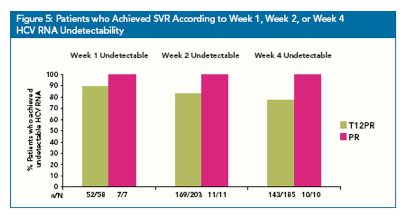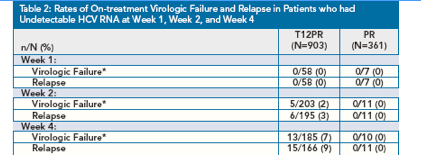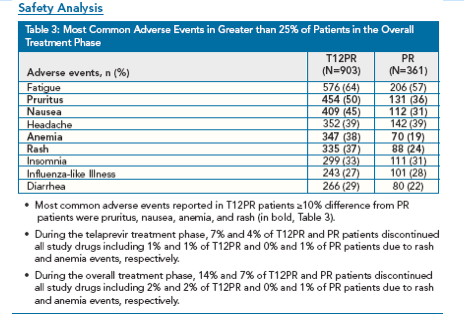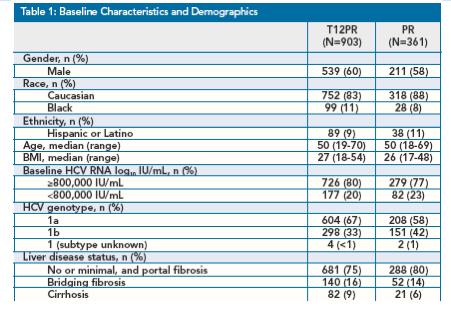 |
 |
 |
| |
Telapravir Promotes Early Clearance of HCV RNA With PEG-IFN/RBV, Early Response Predicts Outcome (weeks 1,2,4)
|
| |
| |
Download the pdf here
18th Conference on Retroviruses and Opportunistic Infections, February 27-March 2, 2011, Boston
Mark Mascolini
"Patients treated with a telaprevir-based regimen, who had early HCV RNA undetectability, had higher sustained viral response rates......Among telapravir-treated people with undetectable HCV RNA after 1 week of therapy, 90% attained a sustained virologic response (SVR, undetectable HCV RNA 6 months after treatment ends), if undetectable at week 2 83% achieved SVR, and if undetectable at week 4 77% achieved SVR."
"More patients were undetectable for HCV RNA at early timepoints when treated with a telaprevir-based regimen.
-- 6%, 22%, and 20% of T12PR patients had first undetectable HCV RNA at Week 1, Week 2, and Week 4, respectively.
-- 2%, 3%, and 3% of patients treated with peginterferon alfa-2a/ribavirin alone had first undetectable HCV RNA at Week 1, Week 2, and Week 4, respectively."
"Regardless of treatment regimen, patients with early HCV RNA undetectability had higher sustained viral response rates, however, as stated above, fewer patients treated with peginterferon alfa-2a/ribavirin alone had undetectable HCV RNA at early viral timepoints compared to patients who received telaprevir-based regimen."
"A majority of patients treated with a telaprevir-based regimen received 24 weeks of total treatment while all patients treated with peginterferon alfa-2a/ribavirin alone received 48 weeks of total treatment.5,6"
"There were low discontinuation rates of all study drugs due to rash and anemia events during the telaprevir treatment phase with overall discontinuation rates due to adverse events of 7% and 4% in T12PR and peginterferon alfa-2a/ribavirin patients respectively."
----------------------------------
Adding telapravir to pegylated-interferon/ribavirin (PEG-IFN/RBV) lowered HCV RNA to undetectable levels more often in the first 4 weeks of therapy than PEG-IFN/RBV alone in HCV type 1-infected people enrolled in two large clinical trials [1]. Among telapravir-treated people with undetectable HCV RNA after 1 week of therapy, 90% attained a sustained virologic response (SVR, undetectable HCV RNA 6 months after treatment ends), if undetectable at week 2 83% achieved SVR, and if undetectable at week 4 77% achieved SVR.
Phase 3 trials of telapravir demonstrate that adding this HCV NS3-4A protease inhibitor to PEG-IFN/RBV significantly improves SVR and usually trims treatment duration to 24 weeks. This retrospective analysis pooled patients enrolled in two phase 3 telapravir trials: ADVANCE was a randomized placebo-controlled trial of telapravir plus PEG-IFN/RBV in HCV genotype 1-infected treatment-naive people. ILLUMINATE was an open-label noninferiority trial that compared telapravir response at 24 and 48 weeks in genotype 1-infected treatment-naive people who had undetectable HCV RNA at weeks 4 and 12.
Study participants had to be 18 to 70 years old and to have evidence of chronic hepatitis by liver biopsy within 1 year of screening for these studies. People with compensated liver cirrhosis were included. HCV RNA levels were measured on day 1 and at weeks 1, 2, 3, 4, 6, 8, 10, 12, 16, 20, 24, 28, 36, 40, and 48 with an assay that has a detection limit of 25 IU/mL.
The pooled analysis included 903 people from ADVANCE or ILLUMINATE who were treated with telapravir plus PEG-IFN/RBV for 12 weeks and for either 24 or 48 weeks with PEG-IFN/RBV. The investigators compared them with 361 people who received only PEG-IFN/RBV in ADVANCE. Both the telapravir group and the PEG-IFN/RBV-only group had a higher proportion of men than women (60% and 58%) and a higher proportion of Caucasians than other races (83% and 88%). Median age (50 years) and body mass index (27 and 26 kg/m[2]) were equivalent in the two groups, and similar proportions began treatment with HCV RNA levels at or above 800,000 IU/mL (80% and 77%). Most people in both groups (75% and 80%) did not have bridging fibrosis or cirrhosis.
After 1, 2, and 4 weeks of treatment, much higher proportions in the telapravir group than the PEG-IFN/RBV-only group had undetectable HCV RNA:
Week 1: 6% versus 2%
Week 2: 22% versus 3%
Week 4: 20% versus 3%
Rapid virologic response (undetectable HCV RNA at week 4), extended rapid virologic response (undetectable at weeks 4 and 12), and SVR were greater with telapravir plus PEG-IFN/RBV (70%, 63%, and 73%) than with PEG-IFN/RBV alone (9%, 8%, and 44%).
Regardless of treatment arm, everyone with undetectable HCV RNA at week 1 (58 of 58 on telapravir and 7 of 7 on PEG-IFN/RBV alone) had undetectable HCV RNA at the end of treatment. Fifty-two of 58 people in the telapravir group (90%) and 7 of 7 in the PEG-IFN/RBV-only group who had undetectable HCV RNA at week 1 achieved SVR. In the telapravir group, 83% with undetectable HCV RNA at week 2 and 77% undetectable at week 4 attained SVR.
Among 903 people in the telapravir group, 66 (7%) experienced virologic failure, compared with 115 of 361 (32%) in the PEG-IFN/RBV-only group. Relapse rates were 8% with telapravir and 28% with PEG-IFN RBV only.
Side effects proved more frequent with telapravir-containing therapy. Compared with the PEG-IFN/RBV-only group, higher proportion in the telapravir group had itching (50% versus 36%), nausea (45% versus 31%), anemia (38% versus 17%), and rash (37% versus 24%). Throughout treatment, 14% in the telapravir group and 7% in the PEG-IFN/RBV group stopped all study drugs. (from Jules: the side effects profile is as expected, no unexpected reports).
This poster is online at the link provided in the reference.


*Patients who met virologic stopping rule (Week 4 HCV RNA > 1000 IU/mL patients receiving telaprevir-based regimen were to discontinue telaprevir and continue PR, Week 12 HCV RNA < 2 log10 decrease compared to baseline, patients were to discontinue
all study drugs, or Week 24 - 36 Detectable HCV RNA > 10 IU/mL patients were to discontinue all study drugs) or had detectable HCV RNA at end of completed treatment.
· Overall 7% (66/903) of T12PR patients experienced virologic failure versus 32% (115/361) of PR patients.
· Overall 8% (64/903) of T12PR patients experienced relapse versus 28% (64/361) of PR patients (Table 2).


Reference
1. Sherman K, Everson G, Jacobson I, et al. Early clearance of HCV RNA in HCV genotype 1 treatment-naive patients treated with TVR, pegIFN, and RBV: pooled analysis of the phase 3 trials ADVANCE and ILLUMINATE. 18th Conference on Retroviruses and Opportunistic Infections. February 27-March 2, 2011. Boston. Abstract 957. http://www.retroconference.org/2011/PDFs/957.pdf.
|
| |
|
 |
 |
|
|